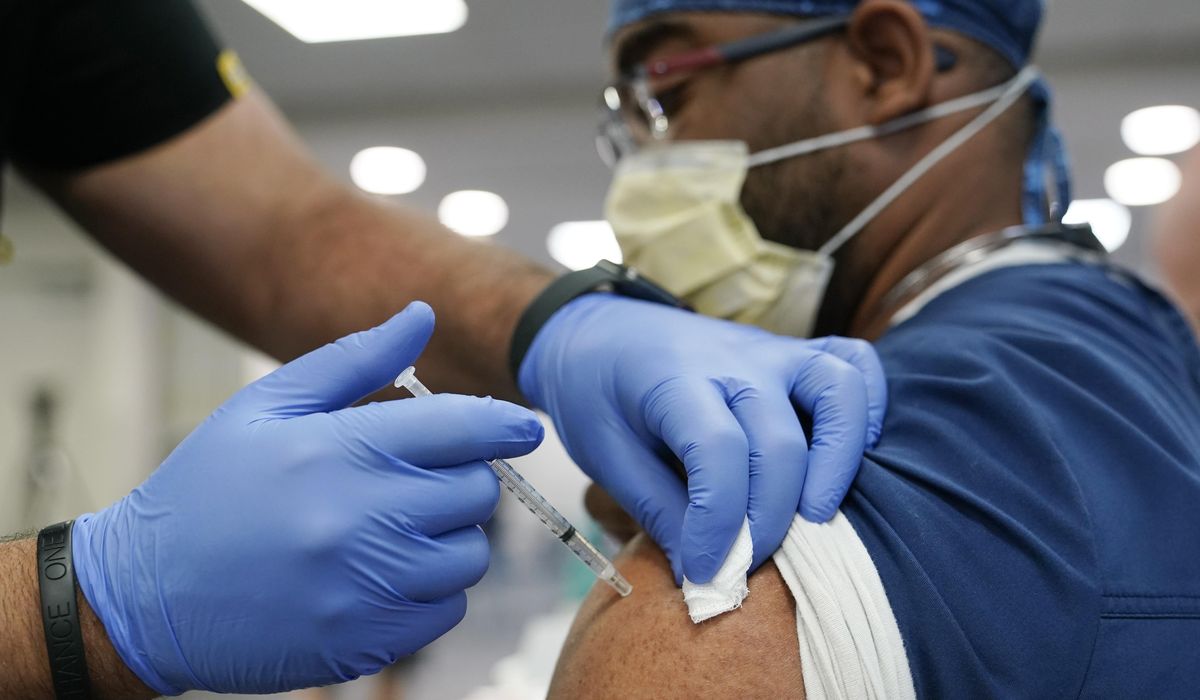Advisers to the Centers for Disease Control and Prevention endorsed a booster plan Thursday for all three COVID-19 vaccines, nudging forward a strategy to let Americans mix-and-match brands to not only bolster their defenses but avoid rare, though serious, side effects that have been linked to both vaccine technologies deployed in the U.S.
The CDC’s Advisory Committee on Immunization Practices voted 15-0 to approve a half-dose booster of the Moderna vaccine alongside a previously approved full-dose Pfizer booster.
They supported an extra dose of the one-shot Johnson & Johnson version by the same margin.
Any adult who received the J&J version at least two months ago is eligible for a boost because of concerns its efficacy lags behind the other versions.
Persons who got their second dose of the Pfizer or Moderna version at least six months ago can come forward if they are over 65, an adult with an underlying health condition or a person in a job that could expose them to the virus.
CDC Director Rochelle Walensky must decide whether to adopt the recommendations in guidance for states.
If she accepts it as expected, millions more will join the 11.6 million Americans who’ve received Pfizer boosters — and they will start comparing vaccines instead of taking what they can get after the Food and Drug Administration this week blessed a mix-and-match strategy that lets anyone eligible for a booster choose from the trinity of approved vaccines.
A chunk of the 15 million Americans who received the one-shot Johnson & Johnson version might switch to another vaccine instead of accepting another J&J dose. Studies showed a bigger antibody jump in persons who got the Moderna and Pfizer version as a booster.
“Vaccinators would love the flexibility with mixing boosters. And yes, I believe that recipients of one vaccine are asking for a booster with the other, especially those who are more literate with the science behind what we call heterologous’ boosting,” Litjen Tan, the chief strategy officer at the Immunization Action Coalition, told The Washington Times, using the technical term for switching.
Dr. Tan said there might be some challenges. For instance, record keeping will be essential to see how mix-and-matching works and whether there are adverse reactions.
Some people might not know which brand to pick. Dr. Tan said patient confusion around choice might be solved by limited inventory at specific sites.
“The vaccinator will only need to boost with the vaccine [she or he] has on hand,” he said.
Another upside to vaccine-switching emerged during Thursday’s discussion. Young men and women potentially could avert side effects that have loomed over the rollout by crossing over to a vaccine that was manufactured differently.
CDC officials said there have been 47 confirmed reports of a rare blood clotting problem, known as thrombocytopenia syndrome (TTS), in the U.S. out of 15.3 million recipients of the one-shot J&J vaccine made by the drugmaker’s Janssen division. There have been five deaths from the problem, which tends to impact women under age 50.
Dr. Pablo J. Sanchez, a pediatrics professor at Ohio State University and ACIP member, said he thinks J&J recipients need a booster but he is “very, very concerned” about the idea of a second J&J dose given the blood-clotting risk that’s been also documented around the AstraZeneca version in Europe, which also used an inactivated, or adenovirus, platform.
Meanwhile, there are concerns about inflammation of the heart muscle, or myocarditis, in young males who receive the Pfizer or Moderna vaccines that use messenger RNA to teach the body to detect and fight the virus.
Rates of the condition, which tends to be mild and occur after the second dose, are as high as 100 cases per 100 million doses in males younger than 20.
Some advisers said mixing and matching might allow recipients to cross over to a safer option for their group.
“I worry about young women and TTS with the Janssen and I flip it over and worry about myocarditis and young men,” said Dr. Helen Keipp Talbot, an associate professor of medicine at Vanderbilt University in Nashville. “I think the opportunities for these heterologous boosts are priceless. If gives those who received Janssen — if you’re a young woman, to receive a messenger RNA. And if you’re a young man who’s received the messenger RNA, maybe you switch over to the Janssen. We’re in a different place in the pandemic than we were earlier, vaccines are readily available.”
The debate around boosters comes amid concern about waning immunity from the initial vaccination series.
The Biden administration made a big push for boosters in August as the delta variant struck and reports of breakthrough infections in the vaccinated spiked, though skeptical scientists said the shots still performed their main function of preventing many hospitalizations and deaths.
CDC advisers continued to say the data around boosters for mRNA vaccines remains thin though agreed J&J recipients could use another dose to boost efficacy rates.
Biden administration officials say they are pushing boosters because they are worried about what might lie ahead and want to be prepared. Regulators might adjust the range of people eligible for boosters in the coming weeks.
“It’s a very dynamic situation. We’re watching it extremely carefully and we’ll take appropriate action to protect the public should it be necessary,” acting FDA Commissioner Janet Woodcock told reporters Wednesday.
Dr. Woodcock’s regulators authorized requests from Moderna and J&J to join Pfizer in offering boosters. It also approved the mix-and-match plan, kicking the concept to the CDC to determine how the strategy should be implemented in the real world.
Penny Heaton, the head of global therapeutics for J&J’s Janssen division, focused on the potential benefits of boosting with another J&J shot in her ACIP presentation. Protection against symptomatic COVID-19 to 94% in the U.S. — up from 74% after a single shot in an earlier study.
FDA officials have said pharmacists and vaccinators will rely on recipients’ word in attesting they qualify for a booster but may use questionnaires to determine eligibility.
Dr. Walensky is expected to accept the ACIP recommendations in issuing guidance to states, though she did break from the panel by adding frontline workers to a recent booster approval for Pfizer.



















